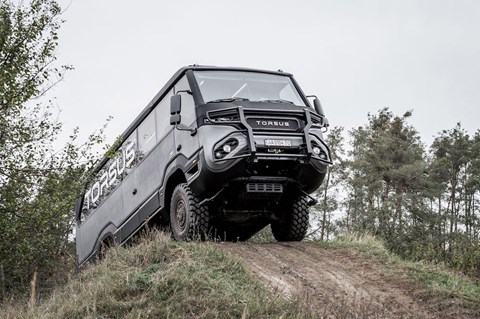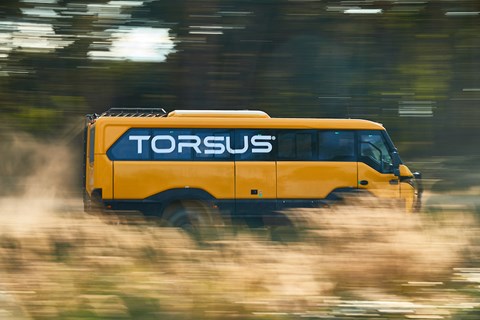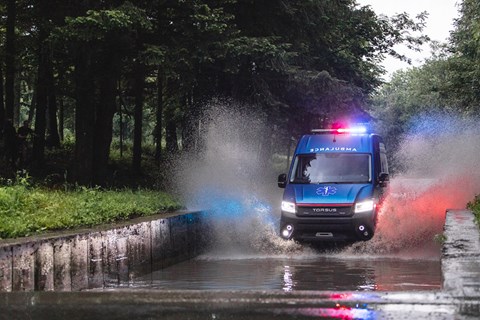► First UK interview with boss of Torsus
► Praetorian and Terrastorm explained…
► …and the thinking behind heavy-duty off-roaders
There is a need for the most extreme of vehicles, plain and simple. But, from the point of view of many, that means things no tougher than a fully loaded-up Defender or Hilux, perhaps modified for purpose to handle certain conditions by aftermarket companies.
Torsus, meanwhile, is on a whole other level.
In case you missed it, the brand came to the forefront of our attention with the reveal of the Praetorian, a gigantic off-road vehicle that seems to have leapt off a sheet of paper in which a nine-year old was designing their ultimate school bus. The brand then followed it up with the VW Crafter-based Terrastorm, a four-wheel drive van that can survive almost anything you throw at it.
Boss of Torsus, Vakhtang Dzukashvili, talked to CAR in his first UK interview on what makes the brand different to anything else you’ll see on, and indeed off, the road.
What on earth is Torsus?
It was founded in 2016 by Dzukashvili and Yuliya Khomich and is based in Czechia. It’s currently busy putting to market both the Praetorian and Terrastorm for global markets, building these extreme machines in Slovakia.

‘The history of Torsus started with our mother company, Pulsar Expo, that is a technical aid business,’ says Dzukashvili, ‘and a huge part of the business is converting vehicles then we deliver them to remote areas with not very strong infrastructure. We started by finding vehicles which we could buy that we could make slight modifications to, but we did not find such things. We decided it would be a nice opportunity to catch up with this niche and deal with it the proper way.’
That ‘proper way’ is what ended up spawning the Praetorian first, then the Terrastorm. ‘Torsus is our baby,’ he adds. ‘The whole concept is about off-road heavy-duty buses. We feel that we probably know the most about the field of people transportation.’
Bold claims…
They are, but Torsus has the goods to prove it. The Praetorian, for example, uses engineering from MAN – one of Europe’s leading commercial vehicle manufacturers – and each one is built to specification. Torsus’ website says an ‘empty shell’ Praetorian will set you back €153,000 (around £137,000); naturally more than that for a bespoke build of any kind. If Amazon fancies delivering parcels up a volcano, a Terrastorm cargo van will cost them around €57,000 (circa £51,000).
Dzukashvili says there are real markets for this kind of vehicle, ranging from mining, the oil and gas industry, law enforcement and the military.

‘I’m Ukrainian and so, with the war with Russia, we saw a lot of problems when the military used normal buses. This didn’t provide them a lot in their time of need to go through fields and the forest. That was another idea to build a bus that can be used by military services; it probably won’t directly save lives but will at least provide more chance to save them.’
‘Business-wise, we needed to improve people transportation in remote areas. We then started working with the oil and gas industry and mining, transportation to quarries, for example.
‘A couple of weeks ago, we had a special request from an agricultural company to build them a mobile laboratory with a small cargo area to prepare operations in the field.’
Can’t a fleet of 4x4s or pickups do these jobs?
They can, but Torsus’ vehicles are purpose-built for such tasks. It also helps that they’re far bigger than your average SUV or pickup.
‘For mining to transport big groups of people, you can use a pickup or SUV but you can obviously put far more people in our Terrastorm. They’re useful as laboratories and repair stations,’ says Dzukashvili. ‘You can’t use an SUV or pickup as, in the back, you have no space; with us you can have several people, workstations and all of your stuff.

‘Then you have things like special forces. They need to have these mobile seats inside and the doors need to be frequently wide open, which you can’t have on an SUV out on military training. When a gentleman is like 2m high, weighs 130kg and has all of his gear on him it’s like the Michelin man coming out, so we provide more comfortable spaces that are still very heavy duty.
‘If you have a Defender or Land Cruiser if you regularly go hunting for example, its only just your transportation. You can’t sit face to face with each other, can’t chat, drink; with our vehicles you can eat together, spend time together, you can provide independent heating for longer stays.’
So, Torsus is even planning on providing them for recreational purposes?
Absolutely, and it’s an area of the market that actually took Dzukashvili and his team by surprise. The Terrastorm is a better fit here, as it’s under 3.5 tonnes and therefore doesn’t need a special drivers’ licence to get behind the wheel. Given the Terrastorm’s own set of wildly imaginative customisation options, a rough n’ ready camper or maintenance van for dirt biking, quad biking and so on can be specced.
‘We have more online traffic coming from the United States than the whole rest of the world combined,’ Dzukashvili points out, ‘and among that is around 25 per cent recreational vehicle-specific. A Terrastorm as a recreational vehicle makes a lot of sense.’
People are really buying these?
‘The main one is mining, because we started from that. We have nice sales with tourism, and we have already started good sales with law enforcement.

‘But the two biggest breakthroughs that we expect to take off next year are the camper and, suddenly for us, the ambulance. There is no purpose-built ambulance for remote areas, so for countries where infrastructure is pretty good but there are fierce winters, they need something for emergency relief. It’s good for military services too, if something happens on a training ground.’
The build process is like that seen at Aston Martin for those special few that are going to take delivery of a Valkyrie. Torsus’ sales team takes a note of your symptoms – how many people you need to ferry about, what terrain and altitude the vehicle will be working on and more – and prescribe you a vehicle that fits. It vastly depends on the specification, but a vehicle usually takes around six months to build and is then shipped off to a VW commercial vehicle or MAN dealer near you.
‘For each customer it is a project-based construction. We understand every single vehicle,’ says Dzukashvili, ‘if you have clay or gravel, for example, that means completely different tyres, even things like worker boots can mean different floors – putting either aluminium sheets or normal PVC in.’
You mentioned VW and MAN…
Yes – Torsus is a business partner with the VW Group, with the massive automotive conglomerate supplying base chassis and powertrains that Dzukashvili’s team then build on and customise.
The biggest benefit is that, by using VW and MAN parts, it allows Torsus to loop into the warranty and servicing scheme. Got a massive Praetorian that needs a repair? You can lump it to your nearest MAN service station. Something gone a bit wonky with your Terrastorm? A Volkswagen commercial vehicle dealer will be provided with a manual to work on it.

‘That is absolutely important for me that you don’t have the problems with servicing,’ Dzukashvili says, ‘that’s the best thing we have with the cooperation.’
What else is Torsus planning?
Dzukashvili says it is looking into if there are other markets that orbit Torsus that the brand could go into, but the key future plan is a concept that is at the forefront of any car makers’ future plans: going electric.
‘Because it’s getting more popular,’ he finishes, ‘we have studied what is possible and I see increasing demand there. We have already had requests for electric buses from places like national parks.’
In the meantime, the Praetorian and Terrastorm will be acting as industrial workhorses, first responders in the wilderness or the ultimate vehicle to survive the apocalypse.